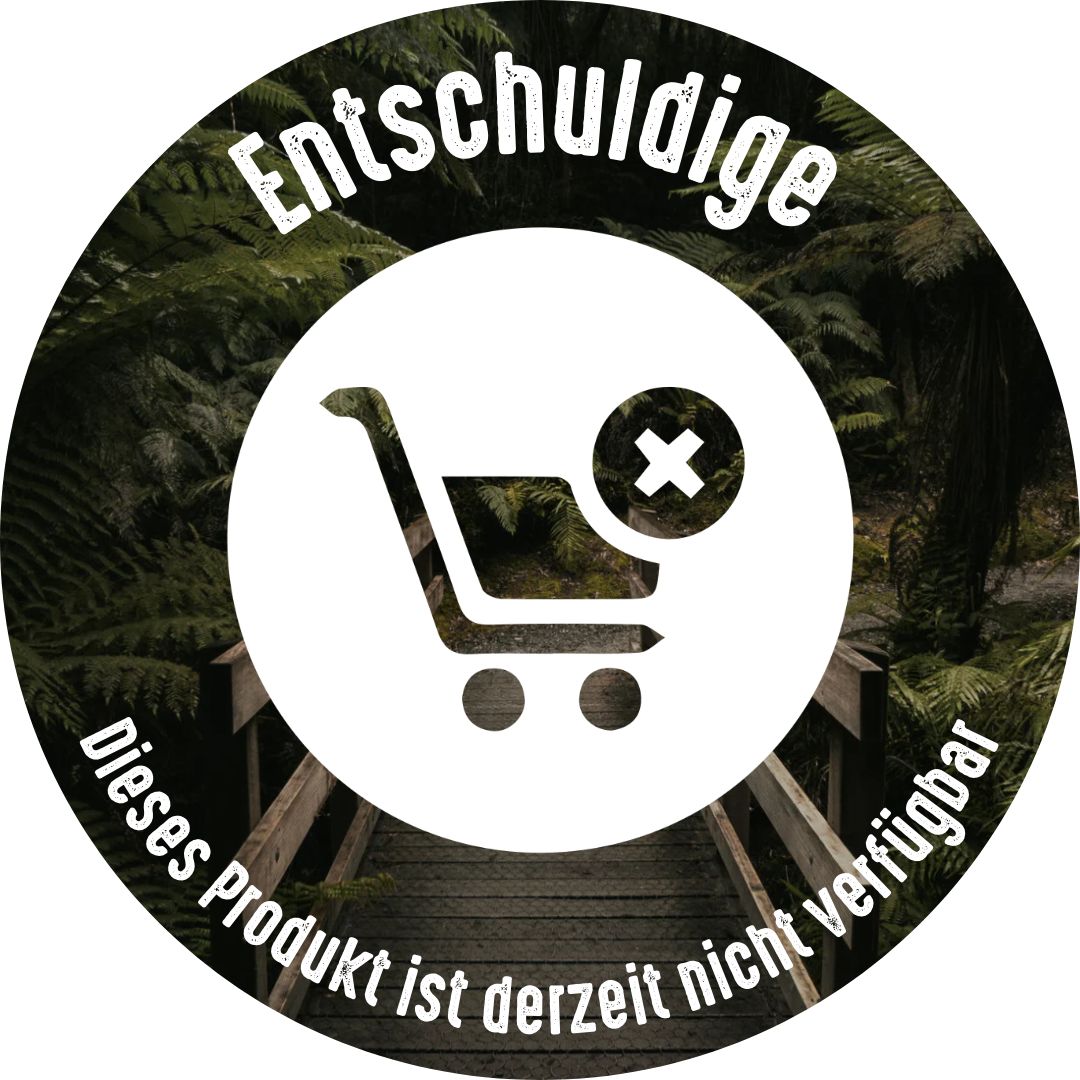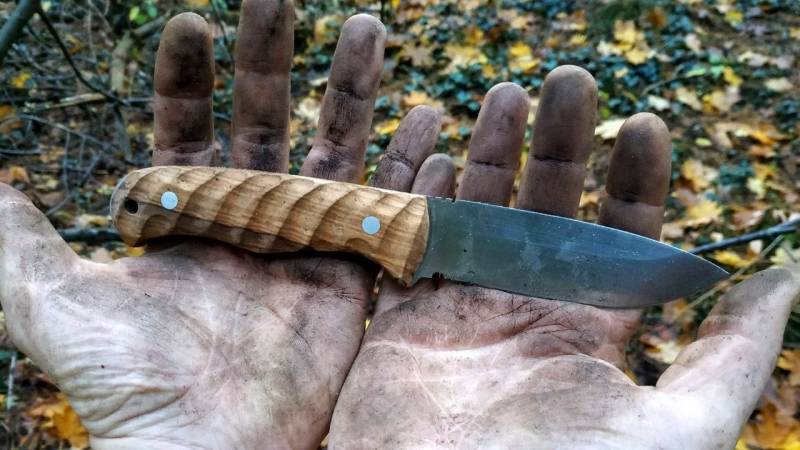
The best bushcraft knife - your ultimate buying guide 2025
👉 The key facts from this guide
- There is no THE perfect bushcraft knife that can do and combine everything. It depends entirely on how you want to use it.
- A good bushcraft knife should be useful for wood processing, be a tool for meal preparation, not be too heavy, have a simple edge, and the blade should be under 13 centimeters.
- The Morakniv Garberg is a robust full tang knife and a winner when it comes to the price-performance ratio.
- The Mora Bushcraft Survival black is robust and stable, not a full tang knife, but like all Morakniv knives, it is robust and stable.
- The Fallkniven F1 is expensive, but worth its price. It is a knife that can handle almost everything.
- The Mora Kansbol belt knife has a Sandvik stainless steel 12C27, is rustproof, and has a plastic handle.
Bushcraft: That means living well in the wilderness.
Your knife is your most important companion.
It must therefore not be difficult and cumbersome, but an efficient all-in-one tool. It must be able to handle everything one needs for effective survival.
Your knife should be able to prepare firewood, build a shelter, cut food, create traps for small animals, and even be used as a weapon in emergencies.
A proper bushcraft knife does all these things and more.
How do we start now?
- I will show you my recommendations for bushcraft knives right away.
- And thereafter, you will learn the basics about knives.
With my buying guide, you will find YOUR bushcraft knife. Or guaranteed to know in the end which type and design is right for you.
The Best List for Bushcraft Knives
Which is the best bushcraft knife you should buy?
My short answer is:
There is no THE perfect bushcraft knife that can do and combine everything.
It depends entirely on how you want to use it.
Often, a bushcraft knife must fulfill the following:
- be useful for woodworking, such as carving
- be a tool for meal preparation (cutting vegetables and meat)
- it must not be too heavy
- have a simple grind (easy to sharpen)
- the blade should be under 13 centimeters (preferably under 12 cm to be legal)
Take a look at my shopping tips and then read my knife basics.
9 Shopping Tips for the Best Bushcraft Knife
With the now 10 featured Bushcraft knives, many Bushcrafters worldwide have gained good experiences. You can't go wrong with them. In the end, I have a cheap and good recommendation for Bushcraft beginners.
1. Morakniv Garberg
The brand Morakniv is known for its high-quality knife products. It has gained a cult following due to its razor-sharp blades and excellent durability, paired with affordable prices.
The Mora Garberg is a robust full tang knife. The winner when it comes to value for money.
The knife has a Scandi grind and is made of stainless Sandvik steel (58 - 59 HRC, 14C28N). It has a sharp and 3.2 mm thick spine, which can be used with a fire starter. The blade is 10.9 cm long, making it legal to carry.
The handle is made of non-slip plastic and the knife can be easily used by left and right-handed individuals. It comes with a plastic sheath that securely holds the knife. The Garberg blade is also offered in carbon steel (check out my review here) (not stainless, but easier to sharpen).
I highly recommend this knife. Morakniv has made a name for itself in the bushcraft community with this knife, and any experienced Bushcrafter will immediately recognize the name "Garberg".
A less robust but more manageable variant of the knife is the Mora Kansbol. I will introduce that one as well.
2. Morakniv Bushcraft Survival black
With the Mora Bushcraft Survival black, you get a knife with a 10.8 cm long blade. It is not a full tang knife, but like all Morakniv knives, it is robust and stable.
The 3.2 mm thick blade made of carbon steel (non-stainless, coated, easy to sharpen) is an absolute beast.
It can, for example, cut through meat like butter or assist you in delicate tasks like the morning bushcraft shave. In the bushcraft camp, the knife can also handle splitting wood and finer carving work.
When you purchase this bushcraft knife, you will receive a diamond sharpener, a Firesteel, and a sheath. The back of the knife is sharp-edged and can be used with the Firesteel. The rubber handle provides a secure grip. The knife sheath is made of lightweight hardcover plastic, as usual.
The affordable price makes it one of the best bushcraft knives available on the market.
The Mora Bushcraft is also available at a lower price without the Firesteel and knife sharpener (view here).
3. Fallkniven F1 Swedish Military
A knife that can handle almost anything.
The Fallkniven is expensive, but worth its price.
The full tang knife will last you a lifetime, and you can even pass it down to your children. With its 9.7 cm long blade, it is perfect for bushcraft. The spine of the blade is quite wide at 4.5 millimeters, making it very sturdy (e.g., for Batoning).
The blade is made of VG10 steel with a hardness rating (HRC) of 59. You also get a stylish leather sheath. The Fallkniven F1 is perfectly balanced and therefore feels great in your hand.
For me, the Fallkniven F1 fits perfectly between bushcraft, tactical/survival, and EDC (every day carry). I can't say that about many knives. With this in mind, I recommend this knife to anyone looking for a compact, robust, and bombproof fixed blade knife.
4. Morakniv Kansbol
The Mora Kansbol belt knife has a Sandvik 12C27 stainless-steel blade and a plastic handle. It comes with a plastic sheath that has a belt loop. It doesn't matter which direction you insert the knife into the sheath - it fits from both directions.
The Morakniv Kansbol is a bushcraft all-round knife with a 10.9 cm long blade. The Scandi grind changes halfway along the blade: the steel gets thinner towards the tip for precision work.
In addition, the blade is 2.5 mm thick at the spine. You can use the sharp-edged spine with your fire steel. The knife is not a full tang knife - Morakniv itself claims that Batoning is not a problem with the Kansbol.
A rubber-plastic coating covers the handle, which is also slip-resistant with wet hands. The Kansbol bushcraft knife is suitable for both right and left-handed users.
Morakniv offers a more stable and robust version of a bushcraft knife with the Mora Garberg (see above).
5. Tops - Brothers of Bushcraft
The Tops Knives B.O.B. (The Brothers of Bushcraft) is a high-quality and robust bushcraft knife. The full tang knife has an 11.8 cm long blade with a Scandi grind.
The blade steel is available in either carbon steel 1095 or the stainless premium high-end steel 154 CM. The 154 CM steel is excellent for sharpening and incredibly durable.
The handle is made of Micarta and has a special extra feature: you will find a hollowed-out section to use the handle as a bow drill handle in case of emergency. Furthermore, the handle is also suitable for large hands. You will receive a high-quality index sheath that perfectly fits the Tops Knives B.O.B. as a sheath.
My conclusion about the Tops - Brothers of Bushcraft: a truly fantastic knife - sturdy and extremely sharp, but expensive.
6. Muela Rhino Olive Fixed Blade Knife
The Muela Rhino comes as a handsome Spaniard with wood. It is a full tang knife with a 10.4 cm long blade made of stainless 4116 steel.
The finely tuned, wide-bellied, and fixed blade is suitable for many tasks in the wilderness. Due to its full tang construction and blade thickness of 4.1 mm, the knife is extremely stable and also suitable for Batoning (The name "Rhino" really suits this blade).
This outdoor knife is excellently crafted and looks fantastic with its olive wood handle scales. The sheath is made of leather and has a belt loop.
7. Joker Arrui
I know it's an affordable outdoor knife, but not everyone has 100 € to spare. That's why I included the full tang knife Arrui. Listen to why I think it's good.
I love "primitive bushcraft" and that's why I like bushcraft knives with wooden handles. The Arrui has such a handle made of olive wood and is made in Spain (Albacete).
The blade is 12 cm long and not too thick with 3 mm on the spine. For me, it's an excellent combination that's just right for woodland crafts.
The blade is made of stainless steel 420, with a hardness of 52 to 54 HRC. The hardness level is not the highest (I generally recommend 55 and higher), but you must not forget that such blades are easier to sharpen. An advantage for bushcraft beginners.
There is also a brown leather sheath to go with it. The knife comes with a 10-year warranty, so why not buy it? The Joker Arrui is also available with a 9 cm long and 3.5 mm thick blade and with a 10 cm long and 3.7 cm thick blade.
You can find a complete review of the Joker Arrui 12 with many photos at "Joker Arrui 12 - a robust and affordable outdoor knife".
8. Casström Woodsman Bog Oak
The Woodsman is an excellent bushcraft knife from the Swedish manufacturer Casström. It is made as a full tang knife and the blade is 8.8 cm long, 4 mm thick at the spine, and made of K720 steel (high carbon content). The spine of the knife is sharp-edged and can be used with a fire steel.
For wood processing, the Scandi grind is perfect and also easy to sharpen. The knife comes with a leather lanyard and a leather sheath. The handle is made of bog oak and looks fantastic.
If you appreciate Swedish craftsmanship, you should take a close look at the Casström knives.
9. Condor Bushlore Knife
The Condor Bushlore Knife is a great all-around knife with a simple design for outdoor enthusiasts. It is a bit expensive, but it is worth it if you are looking for a high-quality bushcraft knife.
The blade is made of 1075 carbon steel, which makes it strong and durable. The handle is made of walnut, which provides a good grip even when wet.
The Scandi grind helps the blade stay sharp for longer and is great for working with wood. And the leather sheath that comes with the knife provides protection and easy carrying options.
I found the knife to be very solid and believe that with proper care, it should last a lifetime. As a bushcraft knife, I would recommend it anytime.
10. Beginner Tip: The Mora Companion
Every Bushcrafter who has been around for a while knows it: the Mora Companion. Well-made, grippy, hard steel, and Scandi grind. And all that for 15 to 20 €.
For outdoor enthusiasts, the Mora Companion Bushcraft Knife is a practical helper. It is not only suitable for Bushcrafters, but also for hikers, hunters, anglers, and preppers.
The Mora Companion is produced in two versions: once with a stainless-steel blade (rustproof, 12C27, 58 HRC) and once with a blend of carbon steel (59 - 60 HRC). Both blades have a classic Scandi grind. Sharpening the carbon steel blade is easier than with bushcraft knives made of pure stainless steel.
The handle material is quite soft and even large hands grip it well. The Companion is not a full tang knife and is therefore not suitable for splitting wood or chopping wood (also because of the Scandi grind). Some Bushcrafters still do it, maybe because it is so cheap and can be quickly replaced.
The knife is perfect for beginners in bushcraft - affordable and yet of excellent quality. It can be used for almost all bushcraft tasks. I always have it with me on my trips and use it regularly.
Reading tip: Bushcraft Beginner Equipment - 5 Equipment Items Every Bushcraft Beginner Needs.
Now you know my recommendations. In order for you to better understand them, I would like to give you a closer look at all the basics of bushcraft knives.
Bushcraft Knife vs. Survival Knife vs. Pocket Knife vs. Hunting Knife
Let's take a closer look at the differences between a Bushcraft knife, Survival knife, and Pocket knife.
Bushcraft Knife
Bushcraft knives are fixed-blade knives and are mainly used for woodworking. You carve sharp points, Feathersticks, notches, or build traps with these knives. A good characteristic of bushcraft knives is the shorter blade compared to survival knives, making them more handy.
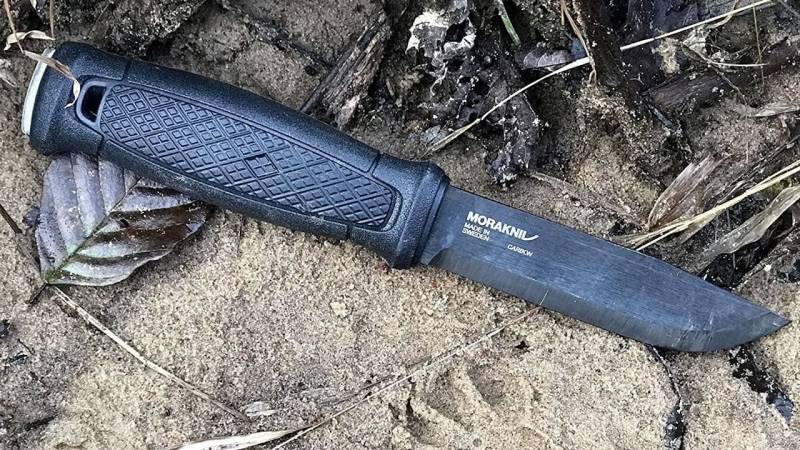
| Concept | designed for woodworking (carving, notching, splitting), not as robust as a survival knife |
| Thickness | between 2 and 4 millimeters, not as thick as a survival knife |
| Length | approximately 8 - 15 cm long, shorter than a survival knife, but more handy and lightweight |
| Cutting Performance | better cutting performance than a survival knife, often due to a thinner blade |
Survival Knife
Survival knives are also fixed-blade knives and are larger than bushcraft knives and pocket knives.
Survival knives are considered all-rounders; you use them to chop and split branches or cut thick materials. You can also fell small trees with a survival knife.
For this, I have a detailed buying guide and my top list of survival knives.
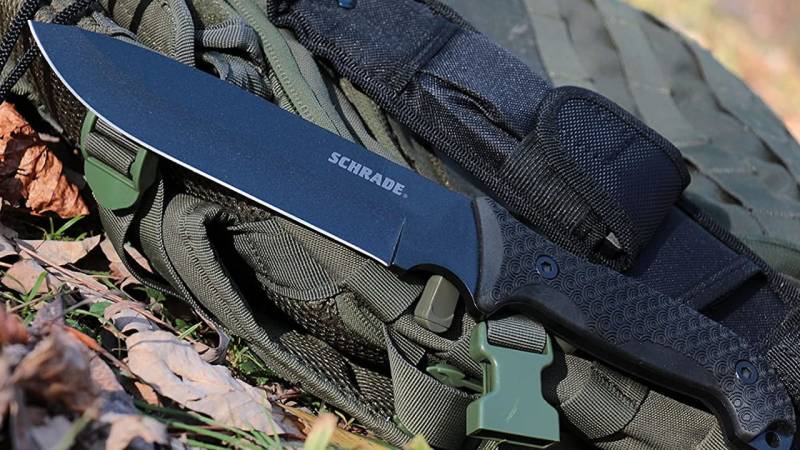
| Concept | a robust all-purpose knife for heavy-duty work (splitting, prying, chopping, striking) |
| Thickness | 4 to 6 millimeters, thicker than a bushcraft knife |
| Length | approx. 12 - 18 cm, has a longer blade than a bushcraft knife, but heavier and less handy |
| Cutting Performance | not as good cutting performance as a bushcraft knife |
Pocket Knife
Pocket knives are folding and smaller than the two other types of knives listed here. You simply put it in your pocket and use it for everyday tasks. It is not suitable for proper woodwork in a bushcraft camp.
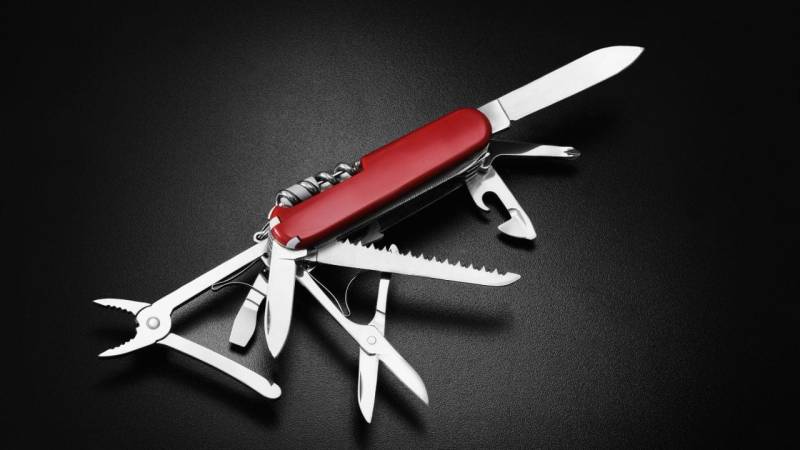
Hunting Knife
A hunting knife is a type of knife designed for hunting and capturing animals.
It is typically used for skinning, cutting, or spearing. A hunting knife is also used for fishing. These knives do not have a long blade and are usually made of high-quality steel.
A good hunting knife should always have a sharp edge and a strong, sturdy handle. Yakut knives are also good hunting knives and have the special chisel grind (here is my guide).
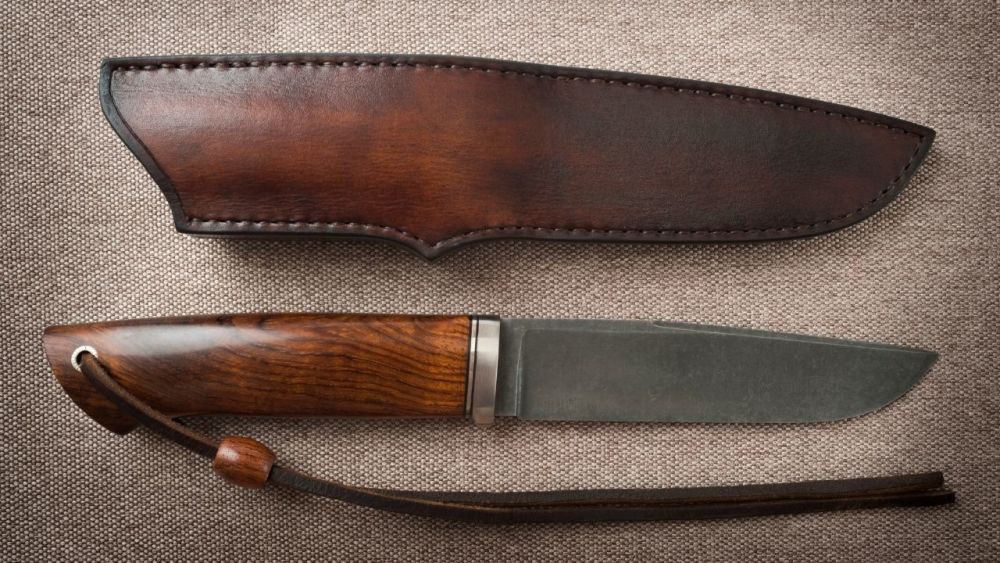
My recommendation: The best bushcraft knife should be a fixed blade knife (full tang) so that you can perform heavy-duty tasks. The blade length should not exceed 15 cm.
I do not recommend a folding knife because it does not provide the necessary stability for me and is unsafe due to the folding mechanism.
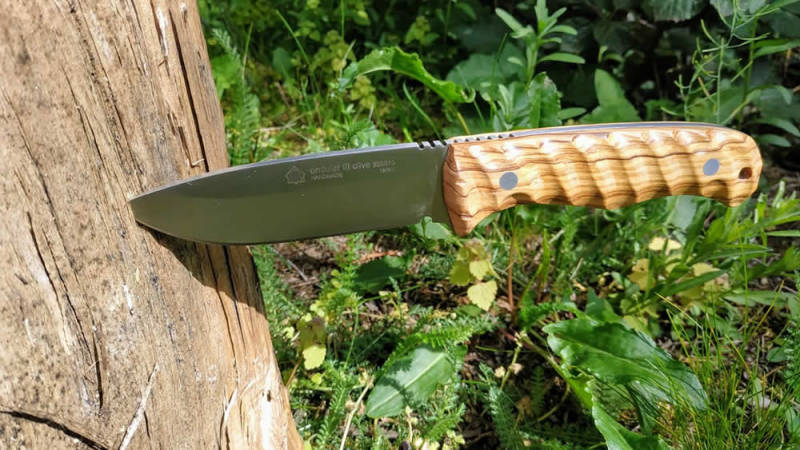
You will quickly find that there are various models and brands of bushcraft knives on the market. How do you now choose the right one for your needs?
There is no "best" bushcraft knife. It all depends on your situation.
Martin Gebhardt
7 Tips for Choosing the Best Bushcraft Knife
Now I will show you 7 important points that will make it easier for you to choose your knife. Take your time and read them, you will then be smarter.
1. Blade length
This is the most important factor for me when choosing a bushcraft knife.
- Long blade: it is more cumbersome to carry the knife. The longer the blade, the heavier the knife becomes. On the other hand, a long and thick blade is suitable for heavy-duty tasks. A long blade is not suitable for carving.
- Short blade: is better suited for finer and more delicate tasks (such as carving). On the other hand, smaller and thinner blades may break or bend during heavy-duty tasks.
Another note: In Germany, you are generally not allowed to carry a fixed blade knife with a blade longer than 12 cm. Keep that in mind when choosing your knife. In my guide to knife law in Germany, you will find more information.
If you need a knife that is longer than 15 cm, I recommend using an axe.
There are hatchets and axes that are perfect for bushcraft. Take a look at my article where I introduce the 3 great axes.
The good thing is: An axe is not covered by weapons laws, and you are allowed to own and carry it - no matter how long and big the blade is.
My recommendation: Choose a blade length between 9 and 13 centimeters. It is flexible enough to perform medium to heavy woodworking tasks. But also small enough to handle fine and precise tasks.
2. Blade Thickness / Blade Width
The back of the blade should be approximately 2 - 4 millimeters wide. That is enough to split sticks and branches. You can also perform carving work with it.
For comparison: A survival knife is usually thicker (3 - 6 mm) and can therefore be used for heavy work such as chopping wood. However, it does not cut as well as a bushcraft knife.
My recommendation: Choose a knife that is approximately 2.5 to 3.5 millimeters thick at the spine of the blade.
3. Blade Grind and Blade Design
There are different cuts, each with its advantages and disadvantages.
In the infographic below, I will show you the most common cuts for outdoor knives.
To get a comprehensive overview of the most common cuts, read my guide "What are the common knife cuts for outdoor knives?".
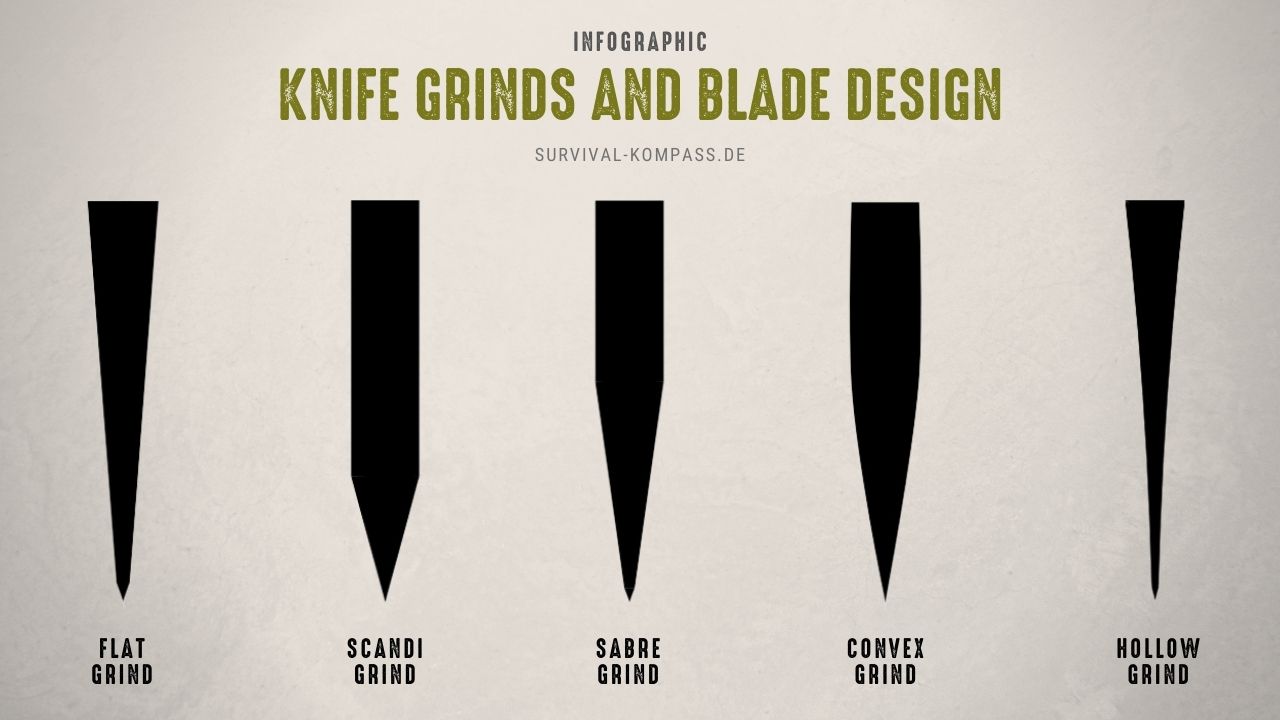
Flat Grind - sharp and durable
Most bushcraft knives have a blade design with a flat grind and a flat edge (also called "Flat Grind" or "High Flat Grind"). A good flat grind, for me, is a combination of Scandi Grind and Sabre Grind.
With the flat grind, you perform fine cutting tasks such as butchering animals or cutting food. Because the edge is so thin, it unfortunately does not hold up well if not handled properly. Even with a very hard steel, the edge can roll or break if you put too much pressure on the blade.
Scandi Grind - for woodworking
With the Scandi Grind (Scandinavian Grind), you can beautifully work with wood, but the blade is more delicate, and you should not chop wood with it. With a Scandi Grind, you can efficiently perform numerous types of cutting tasks.
Furthermore, the Scandi Grind is easy to sharpen. This is especially important for bushcraft beginners to know.
Imagine the Scandi Grind as a double-sided chisel. A chisel efficiently and controlled works on wood - perfect for Bushcrafters who are building a camp, preparing firewood, building a bow drill, building traps, and carving notches. A Scandi grind can remove large amounts of wood, but it is not optimal for Feathersticks.
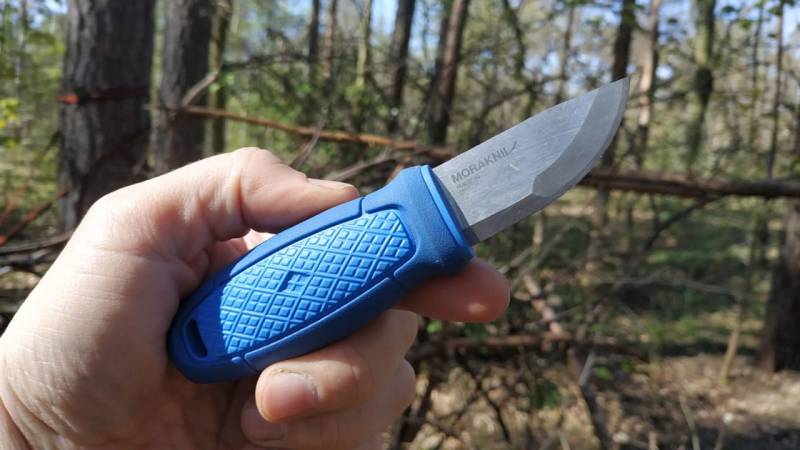
Sabre Grind - for heavy-duty tasks
The Sabre Grind is a combination of Scandi Grind and Flat Grind. The blade is therefore more stable and can be "abused" a bit more than with the Scandi Grind. With the Sabre Grind, you can split branches for firewood or even fell small trees if you don't have an axe or saw at hand. Choose a blade with a good weight so that you can chop well.
Convex Grind - durable and controlled cutting
The convex cuts about as well as a Scandi Grind, but is slightly less durable than a Sabre Grind. It is also called "axe cut", is a strong cut and the sharpness is little affected during work.
With the Convex Grind, you can remove small amounts of material and make finer cuts with control. The convex grind is a mix of durability and controllability. However, it is difficult to sharpen because there are no flat edges.
Hollow Grind - for filleting
When it comes to the Hollow Grind, it's all about a sharp blade. The thinner the edge on the knife, the better it glides through your material.
The hollow grind is one of the thinnest and weakest grinds you can get - but it is very sharp. You mainly use this grind for skinning, gutting, and slaughtering animals. It is not suitable for bushcraft work with wood.
My recommendation: Choose a bushcraft knife with a Scandi grind, it is easy to maintain and sharpen. The Scandi grind is perfect for beginners in bushcraft.
4. Steel of the knife
There are different types of steel, here are the details of the two most important ones:
Carbon Steel
These are knife blades with a high carbon content. They do not dull as quickly, but they rust faster. The material is softer compared to other types of steel, making them easier to sharpen. Such knives require more maintenance by frequently oiling the blade.
The carbon type is available in various variations, such as: O1, A2, CPM D2, D2, 5190, 52100, 1080, 1085, and 1095.
Stainless Steel
The material is the opposite of high carbon content, so it requires more effort to sharpen. But you don't have to worry as much about rusting. Since the steel is very hard, it means less maintenance, but it does not have as sharp an edge as a carbon steel knife.
The stainless-steel variant is available in the following versions: VG10, 440c, CPM S35V, CPM-30V, CPM 154 cm, and CPM 3v.
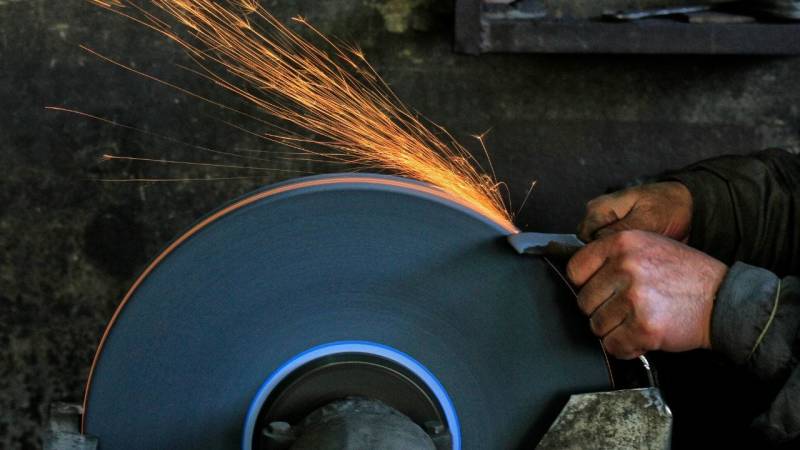
The hardness level of the knife steel
The steel of knives is divided into different hardness grades, and it is a measure of the steel's resistance to deformation. You can find this information in the product descriptions. The measurement is given in the unit "HRC" (What hardness should a knife have? - HRC simply explained).
The hardness of knife steels is most commonly measured using the Rockwell C test. Hardened knife steels typically have a hardness of 55 to 62 HRC. Most knives are equipped with 58 - 60 HRC, although some have up to 62 HRC.
Remember the following:
- Soft steel (e.g., 55 HRC) = easy to sharpen, gets dull quickly
- Hard steel (e.g., 62 HRC) = difficult to sharpen, gets dull slowly
Here's what you should pay attention to:
- Cutting ability - The attribute outweighs all other factors. If the knife doesn't cut well, why would you want to carry it?
- Edge retention - How long does the knife maintain its sharp edge? This is necessary if you intend to be on the go for longer periods without being able to sharpen it.
- Sharpenability - A soft steel is easy to sharpen but also wears out faster. A hard steel is difficult to sharpen, but you only need to sharpen it rarely.
My recommendation: If you start with bushcraft, choose a stainless-steel knife - it requires little maintenance. If you are familiar with sharpening, then buy a carbon steel knife. The hardness level should not be below 55 HRC.
Read also
Which steel is ideal for bushcraft knives? - 7 popular types of steel featured - How to choose the right steel for your bushcraft knife - A handy guide to take your bushcraft skills to the next level.
5. Handle Material
You can often choose between different types of knife handles, such as:
- solid plastic
- (hard) rubber
- Micarta (fiber-reinforced plastic)
- wood
The handle is usually made of wood when it comes to a traditional bushcraft knife. Wood is hard and looks good, but it absorbs moisture. Personally, I love knives with a wooden handle wholeheartedly, as it maintains a natural style.
Rubber and plastic are used to ensure a firm grip on the bushcraft knife. Rubber is a very secure material for me, as it doesn't slip even when it's wet or damp.
Other manufacturers of bushcraft knives, on the other hand, use materials such as Micarta or fiberglass material, which are very robust and therefore durable.
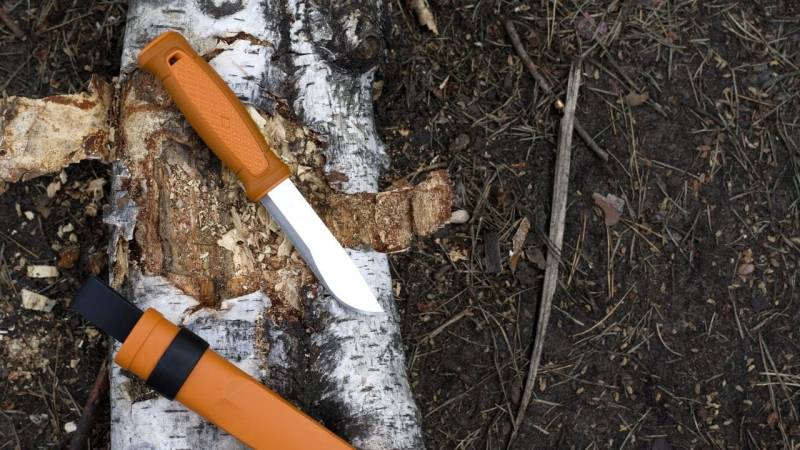
My recommendation: Choose according to your preference and make sure that the bushcraft knife fits securely in your hand.
6. Knife sheath
A sheath belongs to a bushcraft knife. It protects the knife from contamination and secures it safely.
The knife sheath or case can be made of the following materials:
- Leather: traditional, natural, and aesthetic, but it can discolor and wear out. Knives cannot be secured as well in leather sheaths.
- Plastic: lightweight, durable, but not always stylish. Dirt, moisture, and impacts are not a problem.
- Kydex: very durable. Kydex is a thermoplastic material that can be molded. Knife sheaths can be built from it, which are assembled with eyelets and rivets.
My recommendation: Usually, a knife sheath is included with your bushcraft knife. A choice may not always be possible. If needed, have a leather sheath or Kydex holster custom-made.
7. Knife care
Many people see their bushcraft knife as a tool - and it is. But tools need to be maintained.
Clean your knife after each tour, but preferably after each use. And then dry and oil it regularly, so it doesn't rust.
I'll give you these tips along the way:
- do not dig with the knife
- do not cut on a hard surface, such as stones
- do not unnecessarily stab the knife into wood
- do not pry with the blade of the knife
- do not let your blade become too dull
- do not expose the blade to high temperatures (e.g., in a campfire)
Manufacturer
Let's take a quick look at the manufacturers behind these sharp wonders.
Just like a good campfire joke, there are many renowned manufacturers who specialize in the production of bushcraft knives and impress us with first-class quality and functionality.
Here are some renowned outdoor knife manufacturers known for their excellent quality and functionality:
- Mora of Sweden (Morakniv) - A Swedish manufacturer known for its robust and versatile knives.
- Fallkniven - Another Swedish manufacturer known for its high-quality knives and cutting tools for outdoor enthusiasts and professional users.
- Böker - A German manufacturer with a long tradition known for its diverse knives for bushcraft, hunting, and outdoor activities.
- Helle - A Norwegian manufacturer appreciated for its handmade and traditional Scandinavian knives.
- Victorinox - The famous Swiss manufacturer primarily known for its Swiss Army knives (Find my buying guide + top list here), but also for high-quality outdoor knives.
Since I am focusing on the knives themselves in this guide, I would like to recommend my other guide for detailed information on the best outdoor knife manufacturers.
There, I go into detail about the different brands and their special features - as if I were on an exciting search for clues in the forest. See my article on the best outdoor knife manufacturers to learn more and find the ideal manufacturer for your personal bushcraft knife.
Summary
To find the best bushcraft knife, you need to answer the following questions: WHERE and FOR WHAT PURPOSE will I be using it? The environment in which you will be working with the knife should also be taken into consideration.
Choose a few bushcraft knives from my list that caught your attention and compare them. Then you will determine which one you like the most.
Or check out my tips on the characteristics of knives, such as blade length, steel material, grind, etc., and you will surely find a bushcraft knife that suits you.
No matter which knife you choose, go out into nature and use it. "Dirt Time," as the survival expert Tom Brown Jr. calls it, is the most important thing if you want to strengthen your skills in wilderness craft.
And now to you?
What is the BEST bushcraft knife for you?
And please also tell us WHY it is the best knife for you.


Author of the guide
Martin Gebhardt
Hey, I'm Martin. On my blog, you will learn the basics and numerous details about living in the wild. I think survival, bushcraft and the good life in nature are the keys to happiness. Find me here on Instagram or on YouTube. You can find more about my mission on the About Me page.
Since this is a gear guide, here ...
🤝8 reasons to trust my recommendation
-
Practical Experience: I have tested most of the products I recommend under extreme conditions myself.
-
Independence: As a wilderness mentor, I am not tied to any specific brands - this means my recommendations are unbiased.
-
Expertise: My many years of experience allow me to understand the intricacies and details of various products that a layperson might overlook.
-
Target group understanding: I understand the needs and challenges of outdoor enthusiasts, from beginners to seasoned experts.
-
Quality focus: I attach great importance to quality and longevity. These are characteristics that are crucial in the wild.
-
Clear communication: I try to explain the pros and cons of each product clearly and understandably so that you can make an informed decision.
-
Currentness: I always keep my guides up to date and adapt them to new findings or products.
-
Community Feedback: I work in wilderness schools, teach courses myself, attend courses and am active in various outdoor and survival communities and therefore integrate the feedback and experiences of others into my recommendations.
So when I introduce the best survival knives or flashlights, you can be sure that every recommendation is based on solid experience and extensive knowledge.
Was this guide helpful?
123 people found this guide helpful.
4.94 out of 5 points (125 Ratings)
Comments (0)
This post may contain affiliate links. So if you click on the links and make a purchase, I will receive a small commission at no additional cost to you. Click here, to learn more about it.



